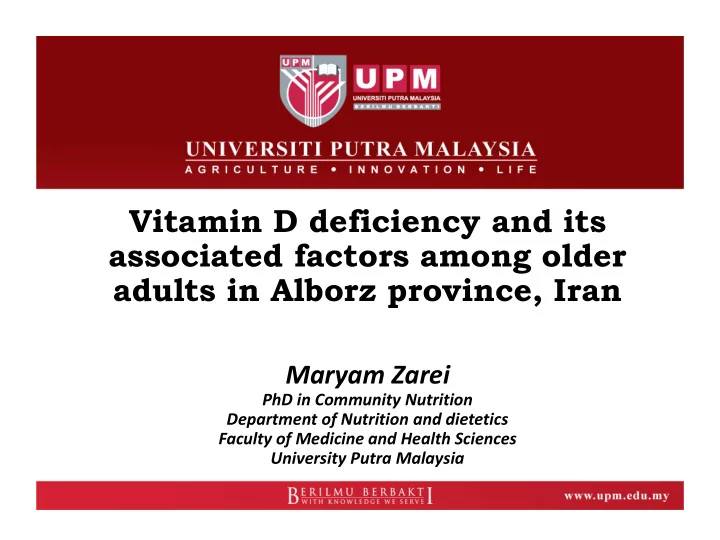

Vitamin D deficiency and its associated factors among older adults in Alborz province, Iran Maryam Zarei PhD in Community Nutrition Department of Nutrition and dietetics Faculty of Medicine and Health Sciences University Putra Malaysia
Acknowledgements • Participants • Ministry of Health, Iran • Alborz Medical University • Dr Geeta Appannah • Co-supervisors – AP Dr Norhasmah Sulaiman, AP Dr Subashini Thambiah, Dr Mostafa Qorbani
OUTLINE OF THE PRESENTATION METHODOLOGY RESULTS CONCLUSION INTRODUCTION
Introduction • Vitamin D is fat soluble seco-sterols. • It has 2 forms; vitamin D2 (or ergocalciferol) and vitamin D3 (or cholecalciferol). • Vitamin D can be obtained from sunlight exposure, food, and supplements.
World prevalence of vitamin D deficiency among adults Country References Percentage Europe countries Cashman et al. 2016 40% Iran Kelishadi et al., 2015 60% Canada Riverin et al., 2014 40% Australia Tiffany et al., 2014 23% Malaysia Chin et al., 2014 % 5 Deficiency 22.7% insufficiency USA Forrest et al., 2011 33%
Ris isk factors for vit itamin D deficiency • Female • Age > 50 • Minimal sun exposure • Dark skin • Obesity Holick et al., 2010, Suryanarayana et al., 2018
Problem statement • Vitamin D deficiency has been associated with various health conditions-osteoporosis, heart disease and dementia • In almost every country, aging is growing faster (WHO, 2015). • The growth in population of the elderly came with particular challenges-chronic diseases and physical disabilities • The 2 nd National Integrated Micronutrient Survey showed 80% of Iranians were vitamin D deficient (UNICEF, 2014). • However, there is a paucity of studies assessing vitamin D deficiency and its associated factors among older adults in Iran.
Objectives To assess the prevalence of vitamin D deficiency and its associated factors including socio demographic, nutritional status, dietary intake, sunlight exposure, health status and food security status among older adults in Karaj city, Alborz province in Iran.
Methods
Methods Study design: Cross sectional • Study subjects : A total of 422 subjects aged 60-80 years were recruited health centres in Karaj city in Alborz province, Inclusion criteria Exclusion criteria Iranian citizen Older adults who were diagnosed with Dementia, Alzheimer, Parkinson Men and women age range over Institutionalized; Disable older adults 60 to 80
Research questionnaire Research instrument Sociodemographic information- age, gender, marital Anthropometry measurement:- status, educational level, occupational status, the height, weight, BMI , number of family members, household income, waist circumference estimation of household expenses per month; financial and food aid from government, ownership Blood pressure measurement Health status - any risk metabolic or diseases problem, use of medicine and use of vitamin D supplementation Food insecurity: adapted Household Food Insecurity Blood sample collection – Access Scale (HFIAS) developed by USDA A 3-mL blood sample was drawn by a qualified nurse. Sun exposure- amount of time people spend in the sun during pass 3 months before recruitment (Score high and low) Food frequency questionnaire- 117 food items
Statistical Analysis • Multiple logistic regression the relationship between socio-demographic status, socio-economic, anthropometric, sun light exposure, food insecurity, dietary intake and vitamin D level • All statistical analyses SPSS (Version 22.0; SPSS Inc, Chicago, IL), was considered significant P <0.05 . 8/22/2018 12
Results
Prevalence of vitamin D
Adjusted associates (odds ratio) of serum 25-hydroxyvitamin D deficiency Variables Adjusted OR (95% CI) p-value Occupations 1 a Others Housewife 1.914 1.211 – 2.240 0.003* Abdominal obesity WC < 90 cm 1 a WC ≥ 90 cm 0.611 0.011 - 0.401 0.108 Hypertension 1 a Normal < 130/ 85 mmHg High ≥ 130/85 mmHg 1.596 1.316 - 1.987 0.011* Sun exposure score High 1 a Low 1.350 1.202-1.557 0.001* BMI Normal BMI < 30 kg/m 2 1 a 1.895 1.629 - 2.331 Obese BMI ≥ 30 kg/ m 2 0.001*
Most influencing associates of serum 25-Hydroxyvitamin D deficiency Variables B Standard Error 95% CI p-value BMI Normal BMI < 30 kg/m 2 0.103 1.109 - 1.915 0.011* Obese BMI ≥ 30 kg/ m 2 1.603 Hypertension Normal < 130/ 85 mmHg 1.456 0.126 1.103 - 1.609 0.001* High ≥ 130/85 mmHg Sun exposure score High 1.116 0.0551 1.023 - 2.187 0.001* Low Occupation level Others 1.054 0.0342 1.012-1.897 0.031* Housewife
Discussion and conclusion • The prevalence of vitamin D deficiency is high among older adults in Alborz province, Iran. • Older adults who were • housewives, • hypertensive, • obese and • had low sun exposure • were more likely to be vitamin D deficient. • Further studies are needed to substantiate these findings and for the development of appropriate interventions to improve serum 25(OH)D levels in older adults
Recommend
More recommend